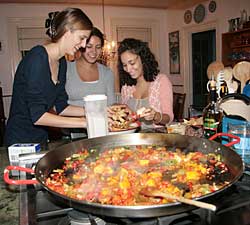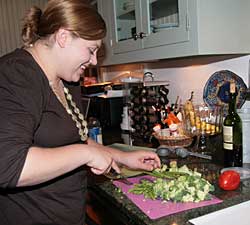Course
Offers Food for Thought
By Rachel Miller ’09
Professor Nancy Sternbach’s
house smells like Spain.
A pan the size of her stovetop sizzles with whole garlic
cloves, onion, red pepper, tomato, and olive oil: the makings
of Spanish vegetable paella. Students chop more vegetables
and watch Sternbach as she leans in to her shelf full of
spices, choosing some delicate Spanish saffron and red “el
angel” pimentón, also Spanish but, she admits,
purchased in Brooklyn.
“It’s so beautiful,” says Sternbach, Professor
of Spanish and Portuguese and the Study of Women and Gender. “It
doesn’t even matter if it tastes good. Who could resist
something this beautiful?” The students, craning to
smell, nod in agreement.

Students in Nancy
Sternbach's course prep ingredients for Paella. |
Welcome to—or more
appropriately, bienvenidos
a— “What’s In a Recipe?” The
first-year seminar combines Sternbach’s many areas
of expertise. Students will learn about the culture of
Spanish-speaking countries by reading recipes and focusing
on the global routes of specific ingredients, like tomatoes
and chocolate, thereby gaining even greater insight into
the economic and political lives of Spanish-speakers.
A portion of the course will focus on women using recipes
as a form of resistance, and a majority of the readings Sternbach
assigns are by Latina authors.
Unfortunately, cooking
is not a regular aspect of Sternbach’s
class. It’s an ideal way for students to connect concepts
they’ve read with a good meal and even better conversation,
but often the chat is life-related, not text-related. In
the classroom students discuss readings, watch films, and
take turns analyzing family recipes. This in-class recipe
work also helps students make connections between the world’s
food and their own.
Hannah Hastings ’12 shared her mom’s
recipe in a recent class for pão dolce,
Portuguese sweet bread. She stands in front of a picture
of sugary loaves. “Because
we only make it once a year, we make tons of it,” explains
Hastings. “When I was little I watched my mom with
her arms up to her elbows in dough, kneading, and I would
reach in and fold up her sleeves if they got in the way.
That was my job.” She raises her arms and squishes
a healthy bicep, proving that Portuguese women have very
strong arms.
 That same day, other students
discuss Michael Pollan’s
book The Omnivore’s Dilemma, a close look
at how America’s food choices estrange eaters from
what food actually is and how it was traditionally eaten.
The class first read about food crime in Deobrah Barndt’s Tangled
Routes, the story of a tomato’s journey from Mexico
to the United States. Barndt investigates the various chemical
alterations required to keep the fruit bright red and firm. That same day, other students
discuss Michael Pollan’s
book The Omnivore’s Dilemma, a close look
at how America’s food choices estrange eaters from
what food actually is and how it was traditionally eaten.
The class first read about food crime in Deobrah Barndt’s Tangled
Routes, the story of a tomato’s journey from Mexico
to the United States. Barndt investigates the various chemical
alterations required to keep the fruit bright red and firm.
“It’s really gross, about the tomatoes,” explains
Krissy Morgan ’12. “You’ve just got to
buy local, it’s so much safer.”
The Omnivore’s
Dilemma brings it even closer
to home. Previously, producing food locally kept costs low,
cites Shannon Pettit ’12. Using modern methods, it
takes so much energy to bring a piece of meat from the field
to the table that it would be impossible to feed everyone
on earth—“which is partly why I’m a vegetarian,” adds
Sternbach. Several students laugh when Dianna Kim ’12
suggests everyone should eat insects.
Anna Leversee ’12 discusses Pollan’s observation
that Americans don’t give proper respect to mealtimes.
One in every five American meals are consumed in the car,
she quotes, and Americans’ propensity for eating while
mobile doesn’t allow the stomach’s digestion
to keep up with the brain. The class agrees, shaking their
heads in dismay.
This reminds Sternbach
of a call she received while chopping ingredients on Paella
night. It was her son’s high
school, phoning to remind her that “the family who
eats together stays together,” and that the child who
eats with his family will undoubtedly get better grades,
too.
At the time she brushed
it off as one of countless annoying pre-recorded messages
she gets each week, but now it serves as the perfect example
of food awareness. We must remain
aware, instructs Sternbach, that our sense of power over
food can make us immune to food’s power.
And that’s precisely
what her class begins to understand when they share a meal
together.
|























